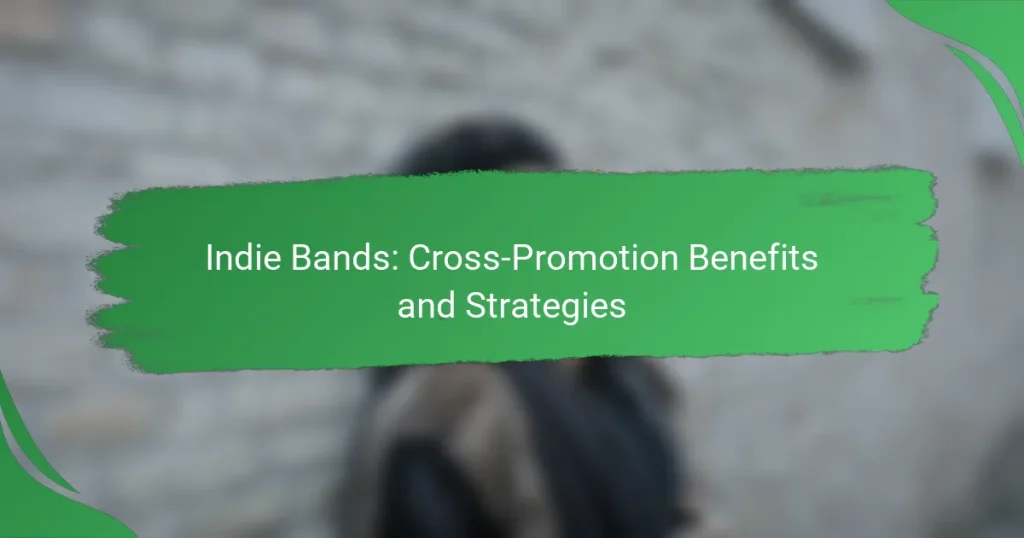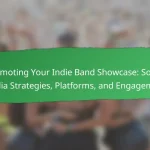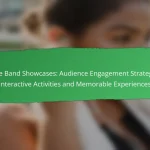Indie bands can greatly benefit from cross-promotion by collaborating with other artists to enhance their visibility and reach. By tapping into each other’s fan bases and sharing resources, these bands can strengthen community ties and navigate the competitive music landscape more effectively. Strategies such as joint merchandise offerings, collaborative music videos, and social media takeovers can help maximize engagement and expand their audience.

How can indie bands benefit from cross-promotion?
Indie bands can significantly enhance their visibility and reach by engaging in cross-promotion with other artists. This strategy allows bands to tap into each other’s fan bases, share resources, and strengthen community ties, ultimately leading to greater success in a competitive music landscape.
Increased audience reach
Cross-promotion enables indie bands to access new audiences by collaborating with other artists who have their own established fan bases. By sharing social media posts, co-hosting events, or featuring each other in music videos, bands can introduce their music to potential fans who may not have discovered them otherwise.
For example, two bands might perform together at a local venue, allowing each group to promote the event to their followers. This can lead to a significant increase in attendance and engagement, as fans are likely to explore the other band’s music after the show.
Enhanced brand visibility
Collaborating with other indie bands can boost brand visibility by creating a unified presence in the music scene. When bands cross-promote, they can leverage each other’s branding elements, such as logos, styles, and messaging, to create a more impactful marketing strategy.
Utilizing platforms like Instagram or TikTok for joint promotional campaigns can help both bands gain traction. For instance, they could create a shared playlist featuring their songs, which can attract listeners who appreciate both styles and increase their overall visibility.
Shared resources and costs
Cross-promotion allows indie bands to share resources, such as marketing budgets, promotional materials, and even studio time. This collaboration can significantly reduce costs, making it easier for bands to invest in high-quality recordings or promotional campaigns.
For example, two bands could split the costs of a music video production, allowing them to create a more polished final product without bearing the full financial burden alone. This approach not only saves money but also encourages creativity through collaboration.
Stronger community ties
Engaging in cross-promotion fosters stronger community ties among indie bands and their fans. By working together, bands can create a sense of camaraderie and support within the local music scene, which can lead to more opportunities for collaboration and growth.
Participating in community events, such as local festivals or charity shows, can further solidify these connections. Bands that support each other in these endeavors can build a loyal fan base that appreciates their collaborative spirit and commitment to the local music community.
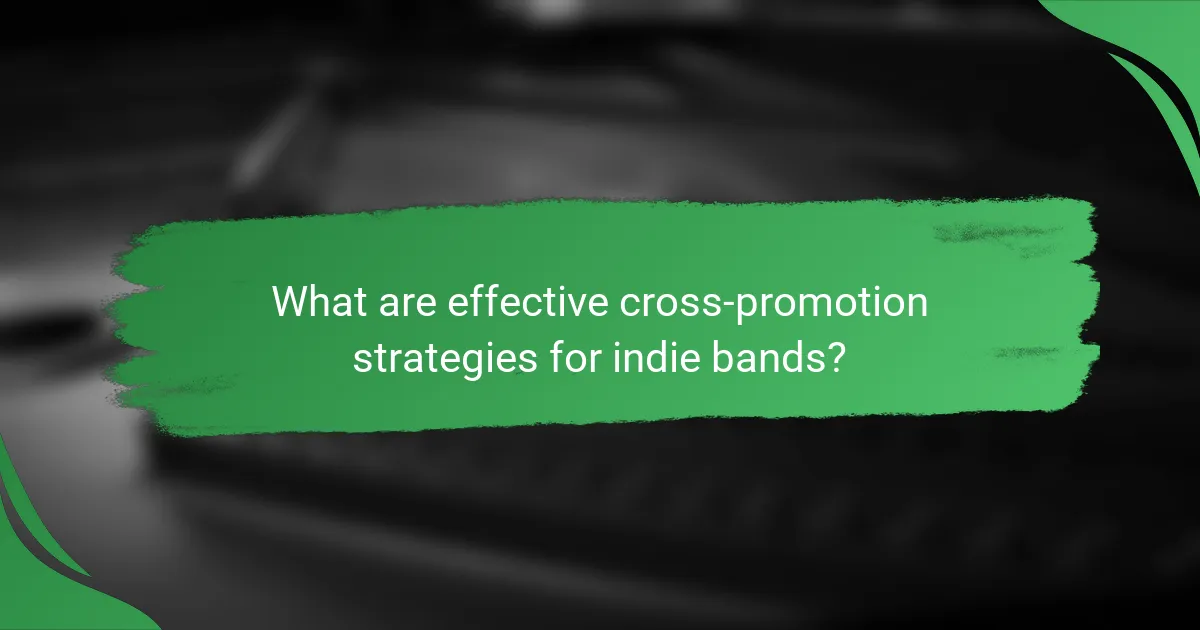
What are effective cross-promotion strategies for indie bands?
Effective cross-promotion strategies for indie bands include collaborative music videos, joint merchandise offerings, social media takeovers, and co-hosted live events. These methods leverage the strengths of multiple artists to expand reach, engage fans, and enhance visibility in a competitive music landscape.
Collaborative music videos
Collaborative music videos allow indie bands to combine their creative talents, resulting in unique content that appeals to both fan bases. By featuring each other in a video, bands can attract viewers from both audiences, increasing exposure and engagement.
When planning a collaborative video, consider the theme and style to ensure it resonates with both groups. Utilize platforms like YouTube or Vimeo for distribution, and promote the video across social media channels to maximize reach.
Joint merchandise offerings
Joint merchandise offerings enable indie bands to create exclusive products that appeal to fans of both artists. This could include limited edition T-shirts, vinyl records, or even collaborative artwork, which can drive sales and foster a sense of community among fans.
To implement this strategy, coordinate designs and pricing to ensure mutual benefit. Consider bundling items at a discounted rate to encourage purchases, and promote these offerings through both bands’ online stores and social media platforms.
Social media takeovers
Social media takeovers involve one band temporarily managing the social media accounts of another, providing fresh content and perspectives. This strategy can engage followers and introduce each band to new audiences, enhancing overall visibility.
Plan the takeover in advance, ensuring that both bands agree on the content and timing. Use engaging formats such as live Q&A sessions, behind-the-scenes looks, or exclusive announcements to keep fans interested and involved.
Co-hosted live events
Co-hosted live events, whether virtual or in-person, allow indie bands to share the stage and attract larger audiences. These events can include joint concerts, festivals, or online streaming sessions, providing fans with a unique experience that showcases multiple acts.
When organizing a co-hosted event, consider logistics such as venue selection, ticket pricing, and promotion. Collaborate on marketing efforts to reach a wider audience, and ensure that both bands are equally represented in promotional materials to maintain balance and fairness.
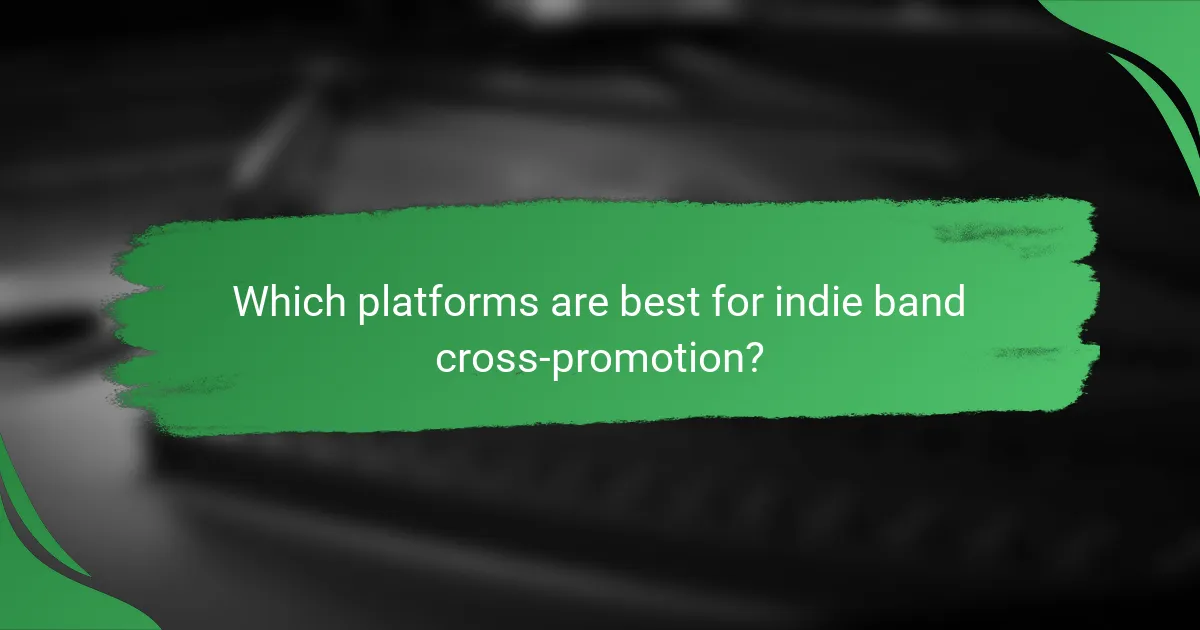
Which platforms are best for indie band cross-promotion?
Indie bands can effectively cross-promote on platforms that enhance visibility and engagement with their target audience. Key platforms include Instagram, Facebook, Spotify, and YouTube, each offering unique features that cater to different promotional strategies.
Instagram for visual storytelling
Instagram is ideal for indie bands to showcase their visual identity through photos and videos. Bands can share behind-the-scenes content, album artwork, and live performance clips to engage fans and create a narrative around their music.
Utilizing Instagram Stories and Reels can further amplify reach, as these features allow for quick, engaging content that can go viral. Collaborating with other artists or influencers on Instagram can also expand audience exposure significantly.
Facebook for event promotion
Facebook is a powerful tool for promoting live events and connecting with local audiences. Bands can create event pages to share details about upcoming shows, allowing fans to RSVP and invite friends, which increases attendance.
Additionally, Facebook Groups can foster community engagement, where bands can interact directly with fans, share exclusive content, and gather feedback. Paid advertising on Facebook can also target specific demographics, enhancing promotional efforts.
Spotify for playlist collaborations
Spotify is essential for indie bands looking to reach new listeners through playlist placements. Collaborating with other artists to create shared playlists can introduce each band’s music to a wider audience.
Submitting tracks to Spotify’s editorial playlists or user-generated playlists can significantly boost streams. Engaging with fans through Spotify’s Canvas feature, which allows for short looping videos, can also enhance the listening experience.
YouTube for video content
YouTube serves as a vital platform for indie bands to share music videos, live performances, and vlogs. High-quality video content can attract new fans and provide a visual representation of the band’s brand.
Collaborating with other YouTubers or musicians for content can drive traffic to a band’s channel. Regularly posting content and engaging with comments can help build a loyal fanbase and improve visibility on the platform.
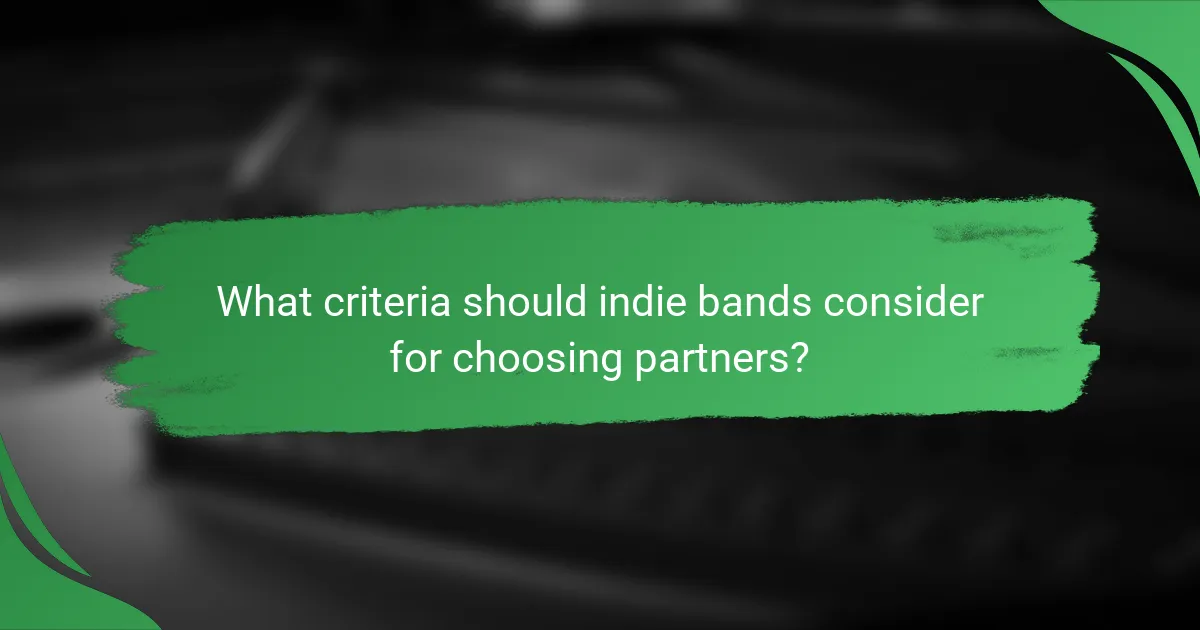
What criteria should indie bands consider for choosing partners?
Indie bands should consider several key criteria when selecting partners for cross-promotion, including musical genre compatibility, audience demographics, and brand values alignment. These factors ensure that collaborations resonate with both bands’ fans and enhance overall visibility.
Musical genre compatibility
Choosing partners with similar or complementary musical genres is crucial for effective cross-promotion. When fans of one band enjoy the sound of another, they are more likely to engage with the collaborative efforts, such as joint performances or shared playlists.
For example, a folk band might partner with an acoustic rock group, as their audiences often overlap. In contrast, a heavy metal band collaborating with a pop artist may not yield the same positive response, as the fan bases may not share interests.
Audience demographics
Understanding audience demographics helps indie bands target the right partners. Factors such as age, location, and listening habits can significantly influence the success of promotional activities.
For instance, if one band has a predominantly young audience while another appeals to an older demographic, their collaboration might not effectively reach either group. Bands should analyze their fan data to find partners with overlapping or complementary audience profiles.
Brand values alignment
Aligning brand values is essential for a successful partnership. Bands that share similar missions, ethics, or artistic visions can create authentic collaborations that resonate with their audiences.
For example, if both bands prioritize sustainability in their music and merchandise, they can jointly promote eco-friendly initiatives, strengthening their appeal to fans who value those principles. Conversely, partnering with a band that has contrasting values may lead to confusion or backlash from fans.
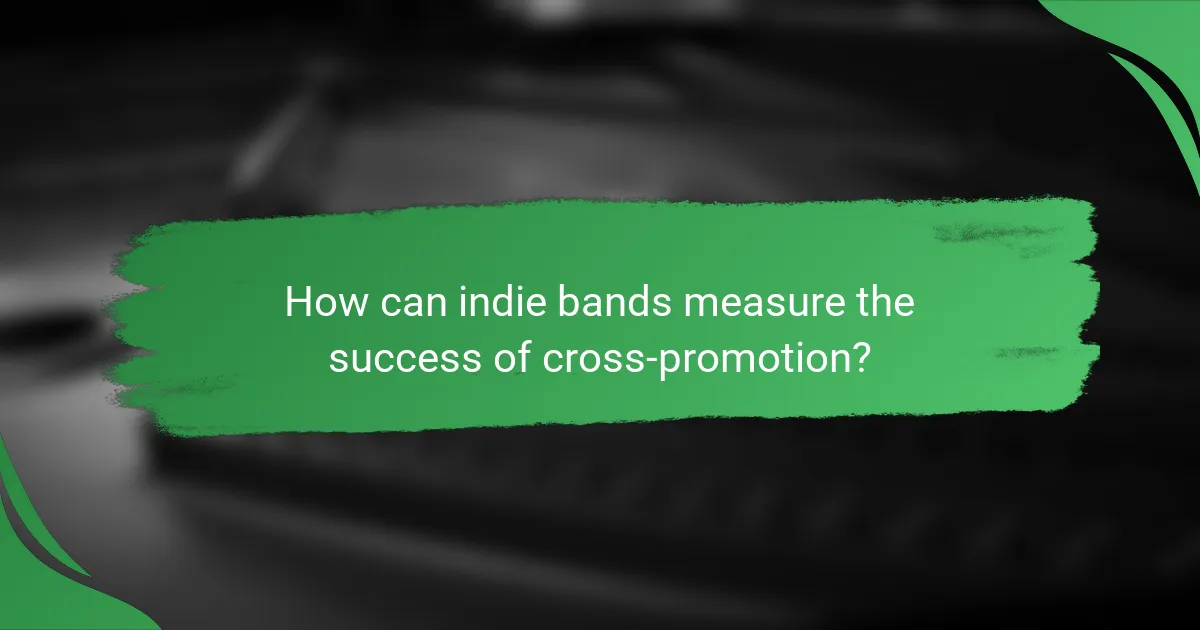
How can indie bands measure the success of cross-promotion?
Indie bands can measure the success of cross-promotion by tracking key performance indicators (KPIs) such as audience engagement, social media growth, and streaming statistics. By analyzing these metrics, bands can assess the effectiveness of their collaborative efforts and adjust their strategies accordingly.
Key Performance Indicators (KPIs)
To effectively measure cross-promotion success, indie bands should focus on specific KPIs. These include social media followers gained, engagement rates on posts, and the number of streams or downloads of promoted songs. Monitoring these metrics over time helps bands understand which strategies resonate with their audience.
For example, if a band collaborates with another and sees a 20% increase in social media followers, this indicates a successful cross-promotion. Similarly, a spike in streaming numbers following a joint release can signal effective collaboration.
Audience Engagement
Audience engagement is a critical factor in determining the success of cross-promotion. Bands should analyze comments, shares, and likes on social media platforms to gauge how well their audience is responding to the collaboration. High engagement rates often correlate with successful promotional efforts.
Indie bands can also conduct surveys or polls to gather direct feedback from their fans about the cross-promotion. This qualitative data can provide insights into what worked well and what can be improved in future collaborations.
Streaming and Sales Metrics
Tracking streaming and sales metrics is essential for measuring the financial impact of cross-promotion. Bands should monitor platforms like Spotify, Apple Music, and Bandcamp for changes in their streaming numbers and sales figures after a promotional campaign.
For instance, if a band experiences a significant increase in sales or streams after a joint concert or social media campaign, it indicates that the cross-promotion was effective. Regularly reviewing these metrics helps bands make informed decisions about future collaborations.
